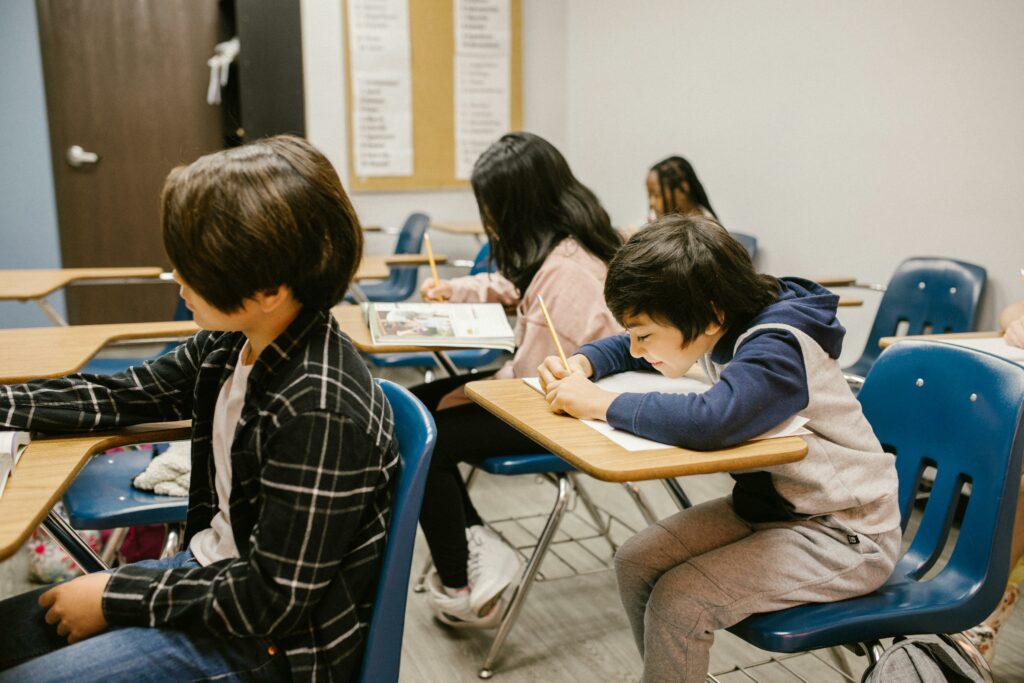
Credit: Allison Shelley/The Verbatim Agency for American Education
For folks in the literacy world, the bitter fight over California’s math framework sounded eerily familiar. On one side, proponents of the framework argued that students need to learn to love math, see themselves as math people and grapple with math concepts. On the other, traditionalists argued that the framework spends too much time on unproven, poorly researched ideas that fail to equip students with the foundational knowledge they need to learn more complex math.
For good measure, there’s even a popular Stanford professor, Jo Boaler, who’s been tagged as the Lucy Calkins of math and whose research has become a lightning rod for criticism from math researchers and educators nationally. Sounds just like the reading wars and the fight between balanced literacy and phonics, doesn’t it?
For those talking about the new “math wars” and calling for a “science of math,” that’s where the similarities end. Yes, there are serious differences between the two sides of the California framework debate on how to teach math in the elementary grades, when students should take algebra and the importance of calculus. But unlike reading, these pedagogical differences are far from being resolved.
That’s because the “science of reading” didn’t happen overnight. It was a multidecade movement engaging every sector of our education system including research, media, advocacy, state and local policy and business to tackle an issue — early literacy — that was broadly understood by the public.
One could argue that the math crisis is far more severe with overall results far behind English and enormous achievement gaps. It is also just as consequential for students, given the connection between early math proficiency and access to higher-level math coursework, post-secondary education and technical careers. To get the attention that math deserves, advocates should learn from the multiyear, multifaceted strategy that’s driven the science of reading movement.
The first step is articulating how poor math instruction affects a child’s life and harms the most vulnerable students, especially students with dyscalculia, a condition that makes it hard to do math. For years, reading advocates have hammered away at the connection between third grade reading results and the school-to-prison pipeline. Meanwhile, dyslexia advocates showed how poor reading instruction harmed children with reading difficulties. Their efforts expanded public consciousness and led to massive philanthropic and government investments in reading research.
For years, ways to teach reading with names like “explicit direct instruction,” “whole language and “balanced literacy” fought it out, creating dissension and confusion down to the classroom level. Over the last decade, stunning advances in neuroscience have resolved most of these conflicts. We now know that learning to read is a complex neurological process marked by explicit sequential stages of learning and interlocking skill development. Approaches like early phonics instruction work for the bulk of students, especially kids with reading difficulties like dyslexia while other popular methods like whole language don’t.
Unfortunately, when it comes to research, math is where reading was 20 years ago, with a similarly animating set of conflicts like the recent California Framework fight pitting “problem-based learning” against procedural knowledge such as memorizing multiplication tables. As we did with reading, we should heavily invest in the neuroscience research that can definitively answer what works in the classroom and what doesn’t.
Simultaneously, we should build the understanding and the will of state and local policymakers and community leaders about the math crisis, its implications for students and the importance of investing in high-quality math instruction from the earliest grades. This means that school districts shouldn’t wait two years for the state to publish a list of approved materials. Most math curricula in California classrooms are low quality and almost 10 years old. Districts should use the flexibility provided by state law to purchase a new highly rated math curriculum and provide ongoing professional learning and coaching for teachers, especially elementary teachers who are often math averse.
As we improve our knowledge of the neuroscience of math, state and local leaders shouldn’t sit on their hands. They should build capacity in state and local agencies by creating math departments that rival the size and influence of their literacy departments, hiring senior math administrators and building a cadre of math coaches so that best practices are quickly disseminated to districts and schools. Using current research, they should regularly revisit their math standards to establish a balance between procedural knowledge and problem-based learning. They should adopt the most vigorous quality metrics for math curriculum and intervention materials and require they are up to date, eliminating lags longer than three years between online updates and district adoptions.
It may be a few years before we have a “science of math” as impactful as the “science of reading.” But with the right focus, research, investments and infrastructure, California can get there with just as many lifelong benefits for our students.
•••
Arun Ramanathan is the former CEO of Pivot Learning and the Education Trust—West.
The opinions expressed in this commentary represent those of the author. EdSource welcomes commentaries representing diverse points of view. If you would like to submit a commentary, please review our guidelines and contact us.


